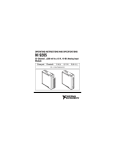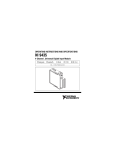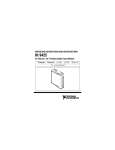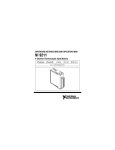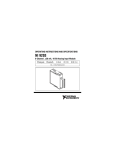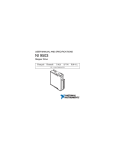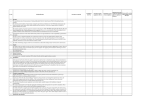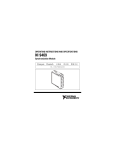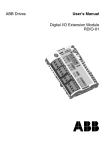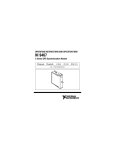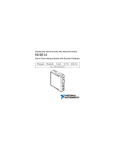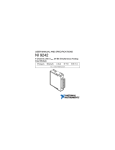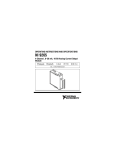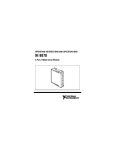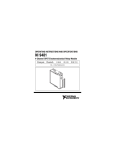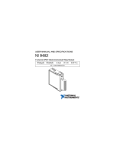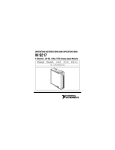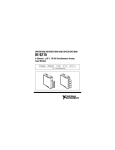Download NI 9411 Operating Instructions and Specifications
Transcript
OPERATING INSTRUCTIONS AND SPECIFICATIONS NI 9411 6-Channel Differential Digital Input Module Français Deutsch ni.com/manuals This document describes how to use the National Instruments 9411 and includes specifications and pin assignments for the NI 9411. Visit ni.com/info and enter rdsoftwareversion to determine which software you need for the modules you are using. For information about installing, configuring, and programming the system, refer to the system documentation. Visit ni.com/info and enter cseriesdoc for information about C Series documentation. Note The safety guidelines and specifications in this document are specific to the NI 9411. The other components in the system might not meet the same safety ratings and specifications. Refer to the documentation for each component in the system to determine the safety ratings and specifications for the entire system. Visit ni.com/info and enter cseriesdoc for information about C Series documentation. NI 9411 Operating Instructions and Specifications 2 ni.com Safety Guidelines Operate the NI 9411 only as described in these operating instructions. Hot Surface This icon denotes that the component may be hot. Touching this component may result in bodily injury. Safety Guidelines for Hazardous Locations The NI 9411 is suitable for use in Class I, Division 2, Groups A, B, C, D, T4 hazardous locations; Class I, Zone 2, AEx nC IIC T4, and Ex nC IIC T4 hazardous locations; and nonhazardous locations only. Follow these guidelines if you are installing the NI 9411 in a potentially explosive environment. Not following these guidelines may result in serious injury or death. Caution Do not disconnect I/O-side wires or connectors unless power has been switched off or the area is known to be nonhazardous. Do not remove modules unless power has been switched off or the area is known to be nonhazardous. Caution © National Instruments Corp. 3 NI 9411 Operating Instructions and Specifications Substitution of components may impair suitability for Class I, Division 2. Caution For Zone 2 applications, install the system in an enclosure rated to at least IP 54 as defined by IEC 60529 and EN 60529. Caution For Zone 2 applications, install a protection device between the Vsup terminal and the COM terminal. The device must prevent the Vsup-to-COM voltage from exceeding 42 V if there is a transient overvoltage condition. Caution Special Conditions for Hazardous Locations Use in Europe This equipment has been evaluated as Ex nC IIC T4 equipment under DEMKO Certificate No. 03 ATEX 0324020X. Each module is marked II 3G and is suitable for use in Zone 2 hazardous locations, in ambient temperatures of –40 °C Ta 70 °C. If you are using the NI 9411 in Gas Group IIC hazardous locations, you must use the device in an NI chassis that has been evaluated as Ex nC IIC T4, EEx nC IIC T4, Ex nA IIC T4, or Ex nL IIC T4 equipment. NI 9411 Operating Instructions and Specifications 4 ni.com Special Conditions for Marine Applications Some modules are Lloyd’s Register (LR) Type Approved for marine applications. To verify Lloyd’s Register certification, visit ni.com/certification and search for the LR certificate, or look for the Lloyd’s Register mark on the module. To meet radio frequency emission requirements for marine applications, use shielded cables and install the system in a metal enclosure. Suppression ferrites must be installed on power supply inputs near power entries to modules and controllers. Power supply and module cables must be separated on opposite sides of the enclosure and must enter and exit through opposing enclosure walls. Caution © National Instruments Corp. 5 NI 9411 Operating Instructions and Specifications Connecting the NI 9411 The NI 9411 has a 15-pin DSUB connector that provides connections for 6 digital input channels. DI0b DI1b DI2b COM DI3b DI4b DI5b 9 10 11 12 13 14 15 Vsup 0 COM 1 1 2 3 4 5 6 7 8 DI0a DI1a DI2a Supply (+5 Vout) Supply (+5 Vout) DI3a DI4a DI5a Figure 1. NI 9411 Pin and Terminal Assignments NI 9411 Operating Instructions and Specifications 6 ni.com Each channel has two pins, DIa and DIb, to which you can connect digital input signals. The DSUB connector also provides two connections for supplying power to an external device and a connection for common. The NI 9411 also has a 2-terminal screw-terminal connector that provides connections for an external power supply. If you do not have a 5 V power supply to directly power the external device or if you want to simplify wiring, you can connect an external power supply to the Vsup and COM terminals on the NI 9411 screw-terminal connector, and connect the external device to one of the 5 Vout pins. If the external device is already powered, you do not need to connect a power supply to the NI 9411 or connect the +5 Vout pin to the external device. Refer to the Specifications section for information about the external power supply specifications. You must use 2-wire ferrules to create a secure connection when connecting more than one wire to a single terminal on the NI 9411 screw-terminal connector. Note Connecting Differential Devices to the NI 9411 You can connect differential devices to the NI 9411. Connect the device to the DIa and DIb pins on the NI 9411. The NI 9411 © National Instruments Corp. 7 NI 9411 Operating Instructions and Specifications measures whether the difference between the DIa and DIb pins is greater than or less than the digital logic levels. If the difference between the pins is within the input high range, the channel registers as high. If the difference between the pins is within the input low range, the channel registers as low. Refer to the Specifications section for more information about digital logic levels. Figure 2 shows a possible configuration. External Power Supply + – Vsup +5 Vout + – Differential Device COM +5 V Reg DIa DIb Receiver Circuitry COM NI 9411 Figure 2. Connecting a Differential Device to the NI 9411 NI 9411 Operating Instructions and Specifications 8 ni.com An example of a differential device is a differential encoder. A differential encoder has phase A, phase B, and index signals. Use the phase A signals to measure rotational speed. Use the phase B signals to measure direction. Use the index signals to measure the number of rotations. Connect each of the signal pairs of the encoder (phase A, phase B, and index) to a pair of DI pins. Figure 3 shows the connections for one differential encoder. © National Instruments Corp. 9 NI 9411 Operating Instructions and Specifications External Power Supply + Vsup +5 V A+ A– B+ B– Index+ Index– Differential Encoder GND +5 Vout DI0a DI0b DI1a DI1b DI2a DI2b – COM +5 V Reg Receiver Circuitry Receiver Circuitry Receiver Circuitry COM NI 9411 Figure 3. Connecting a Differential Encoder to the NI 9411 NI 9411 Operating Instructions and Specifications 10 ni.com Connecting Single-Ended Devices to the NI 9411 You can connect single-ended (TTL) devices to the NI 9411. Connect the signal to the DIa pin, but do not connect a signal to the DIb pin in the pair. You must leave the second signal in the set of signals unconnected. For example, if you connect a single-ended signal to the pin for DI0a, leave DI0b unconnected. Figure 4 shows a possible configuration. External Power Supply + – Vsup +5 Vout out +5 V Reg DIa DIb Single-Ended Device COM Receiver Circuitry COM NI 9411 Figure 4. Connecting a Single-Ended Device to the NI 9411 © National Instruments Corp. 11 NI 9411 Operating Instructions and Specifications An example of a single-ended device is a single-ended encoder. A single-ended encoder has phase A, phase B, and index signals. Use the phase A signal to measure rotational speed. Use the phase B signal to measure direction. Use the index signal to measure the number of rotations. Connect each of the signals of the encoder (phase A, phase B, and index) to a DI pin. Figure 5 shows the connections for one single-ended encoder. NI 9411 Operating Instructions and Specifications 12 ni.com External Power Supply + – Vsup +5 V A B Index Single-Ended Encoder GND +5 Vout DI0a +5 V Reg DI0b Receiver Circuitry DI1a DI1b Receiver Circuitry DI2a DI2b COM Receiver Circuitry COM NI 9411 Figure 5. Connecting a Single-Ended Encoder to the NI 9411 © National Instruments Corp. 13 NI 9411 Operating Instructions and Specifications Wiring for High-Vibration Applications If an application is subject to high vibration, National Instruments recommends that you use ferrules to terminate wires to the detachable screw-terminal connector. Refer to Figure 6 for an illustration of using ferrules. Figure 6. 2-Terminal Detachable Screw-Terminal Connector with Ferrule NI 9411 Operating Instructions and Specifications 14 ni.com Sleep Mode This module supports a low-power sleep mode. Support for sleep mode at the system level depends on the chassis that the module is plugged into. Refer to the chassis manual for information about support for sleep mode. If the chassis supports sleep mode, refer to the software help for information about enabling sleep mode. Visit ni.com/info and enter cseriesdoc for information about C Series documentation. Typically, when a system is in sleep mode, you cannot communicate with the modules. In sleep mode, the system consumes minimal power and may dissipate less heat than it does in normal mode. Refer to the Specifications section for more information about power consumption and thermal dissipation. © National Instruments Corp. 15 NI 9411 Operating Instructions and Specifications Specifications The following specifications are typical for the range –40 to 70 °C unless otherwise noted. All voltages are relative to COM unless otherwise noted. Input Characteristics Number of channels.......................... 6 digital input channels Input type .......................................... Differential or single-ended Digital logic levels Differential (DIa–DIb) Input high range ................... 300 mV to 24 V Input low range .................... –300 mV to –24 V Common-mode voltage1 ...... –7 to 12 V Single-ended Input high range ................... 2 to 24 V Input low range .................... 0 to 0.8 V 1 Common-mode voltage is the average of DIa and DIb. NI 9411 Operating Instructions and Specifications 16 ni.com Input current At 5 V 1 mA per channel At 24 V 4 mA per channel Input impedance................................ 8.4 k I/O protection Input voltage (channel-to-COM) ...................... 30 V max Input current 4 mA, internally limited Input delay time ................................ 500 ns max MTBF ............................................... 800,319 hours at 25 °C; Bellcore Issue 2, Method 1, Case 3, Limited Part Stress Method Note Contact NI for Bellcore MTBF specifications at other temperatures or for MIL-HDBK-217F specifications. © National Instruments Corp. 17 NI 9411 Operating Instructions and Specifications Power Requirements Power consumption from chassis Active mode ............................... 340 mW max Sleep mode ................................. 1.1 mW max Thermal dissipation (at 70 °C) Active mode ............................... 1.4 W max Sleep mode ................................. 1.1 W max External Power Supply Input voltage range (Vsup)................. 5 to 30 VDC max 5 V regulated output Voltage tolerance ........................ 5 V 3%, Vsup 6 V Current........................................ 200 mA Short-circuit protection .............. 400 mA Note The NI 9411 does not provide overvoltage protection. NI 9411 Operating Instructions and Specifications 18 ni.com Physical Characteristics If you need to clean the module, wipe it with a dry towel. Note For two-dimensional drawings and three-dimensional models of the C Series module and connectors, visit ni.com/dimensions and search by module number. Screw-terminal wiring ...................... 12 to 24 AWG copper conductor wire with 10 mm (0.39 in.) of insulation stripped from the end Torque for screw terminals ............... 0.5 to 0.6 N · m (4.4 to 5.3 lb · in.) Ferrules ............................................. 0.25 mm2 to 0.5 mm2 Weight............................................... 136 g (4.8 oz) © National Instruments Corp. 19 NI 9411 Operating Instructions and Specifications Safety Safety Voltages Connect only voltages that are within the following limits. Channel-to-COM or Vsup-to-COM ................................ 30 V max, Measurement Category I Isolation Channel-to-channel .................... None Channel-to-earth ground Continuous ........................... 30 Vrms, 42.4 Vpk, 60 VDC Withstand ............................. 400 Vrms, verified by a 5 s dielectric withstand test Measurement Category I is for measurements performed on circuits not directly connected to the electrical distribution system referred to as MAINS voltage. MAINS is a hazardous live electrical supply system that powers equipment. This category is for measurements of voltages from specially protected secondary circuits. Such voltage measurements include signal levels, special equipment, limited-energy parts of equipment, circuits powered by regulated low-voltage sources, and electronics. NI 9411 Operating Instructions and Specifications 20 ni.com Do not connect the NI 9411 to signals or use for measurements within Measurement Categories II, III, or IV. Caution Hazardous Locations U.S. (UL) .......................................... Class I, Division 2, Groups A, B, C, D, T4; Class I, Zone 2, AEx nC IIC T4 Canada (C-UL) ................................. Class I, Division 2, Groups A, B, C, D, T4; Class I, Zone 2, Ex nC IIC T4 Europe (DEMKO)............................. Ex nC IIC T4 Safety Standards This product meets the requirements of the following standards of safety for electrical equipment for measurement, control, and laboratory use: • IEC 61010-1, EN 61010-1 • UL 61010-1, CSA 61010-1 © National Instruments Corp. 21 NI 9411 Operating Instructions and Specifications Note For UL and other safety certifications, refer to the product label or the Online Product Certification section. Electromagnetic Compatibility This product meets the requirements of the following EMC standards for electrical equipment for measurement, control, and laboratory use: • EN 61326 (IEC 61326): Class A emissions; Industrial immunity • EN 55011 (CISPR 11): Group 1, Class A emissions • AS/NZS CISPR 11: Group 1, Class A emissions • FCC 47 CFR Part 15B: Class A emissions • ICES-001: Class A emissions Note For the standards applied to assess the EMC of this product, refer to the Online Product Certification section. Note For EMC compliance, operate this device with shielded cables. NI 9411 Operating Instructions and Specifications 22 ni.com CE Compliance This product meets the essential requirements of applicable European Directives as follows: • 2006/95/EC; Low-Voltage Directive (safety) • 2004/108/EC; Electromagnetic Compatibility Directive (EMC) Online Product Certification Refer to the product Declaration of Conformity (DoC) for additional regulatory compliance information. To obtain product certifications and the DoC for this product, visit ni.com/ certification, search by module number or product line, and click the appropriate link in the Certification column. © National Instruments Corp. 23 NI 9411 Operating Instructions and Specifications Shock and Vibration To meet these specifications, you must panel mount the system and affix ferrules to the ends of the terminal wires. Operating vibration Random (IEC 60068-2-64)......... 5 grms, 10 to 500 Hz Sinusoidal (IEC 60068-2-6) ....... 5 g, 10 to 500 Hz Operating shock (IEC 60068-2-27).............................. 30 g, 11 ms half sine, 50 g, 3 ms half sine, 18 shocks at 6 orientations Environmental National Instruments C Series modules are intended for indoor use only but may be used outdoors if installed in a suitable enclosure. Refer to the manual for the chassis you are using for more information about meeting these specifications. Operating temperature (IEC 60068-2-1, IEC 60068-2-2) ..... –40 to 70 °C Storage temperature (IEC 60068-2-1, IEC 60068-2-2) ..... –40 to 85 °C Ingress protection.............................. IP 40 NI 9411 Operating Instructions and Specifications 24 ni.com Operating humidity (IEC 60068-2-56).............................. 10 to 90% RH, noncondensing Storage humidity (IEC 60068-2-56).............................. 5 to 95% RH, noncondensing Maximum altitude............................. 2,000 m Pollution Degree ............................... 2 Environmental Management National Instruments is committed to designing and manufacturing products in an environmentally responsible manner. NI recognizes that eliminating certain hazardous substances from our products is beneficial to the environment and to NI customers. For additional environmental information, refer to the NI and the Environment Web page at ni.com/environment. This page contains the environmental regulations and directives with which NI complies, as well as other environmental information not included in this document. © National Instruments Corp. 25 NI 9411 Operating Instructions and Specifications Waste Electrical and Electronic Equipment (WEEE) At the end of the product life cycle, all products must be sent to a WEEE recycling center. For more information about WEEE recycling centers, National Instruments WEEE initiatives, and compliance with WEEE Directive 2002/96/EC on Waste and Electronic Equipment, visit ni.com/environment/ weee. EU Customers ⬉ᄤֵᙃѻક∵ᶧࠊㅵ⧚ࡲ⊩ ˄Ё RoHS˅ Ёᅶ᠋ National Instruments ヺড়Ё⬉ᄤֵᙃ ѻકЁ䰤ࠊՓ⫼ᶤѯ᳝ᆇ⠽䋼ᣛҸ (RoHS)DŽ݇Ѣ National Instruments Ё RoHS ড়㾘ᗻֵᙃˈ䇋ⱏᔩ ni.com/environment/rohs_chinaDŽ (For information about China RoHS compliance, go to ni.com/ environment/rohs_china.) NI 9411 Operating Instructions and Specifications 26 ni.com Where to Go for Support The National Instruments Web site is your complete resource for technical support. At ni.com/support you have access to everything from troubleshooting and application development self-help resources to email and phone assistance from NI Application Engineers. National Instruments corporate headquarters is located at 11500 North Mopac Expressway, Austin, Texas, 78759-3504. National Instruments also has offices located around the world to help address your support needs. For telephone support in the United States, create your service request at ni.com/support and follow the calling instructions or dial 512 795 8248. For telephone support outside the United States, contact your local branch office: Australia 1800 300 800, Austria 43 662 457990-0, Belgium 32 (0) 2 757 0020, Brazil 55 11 3262 3599, Canada 800 433 3488, China 86 21 5050 9800, Czech Republic 420 224 235 774, Denmark 45 45 76 26 00, Finland 358 (0) 9 725 72511, France 01 57 66 24 24, Germany 49 89 7413130, India 91 80 41190000, Israel 972 3 6393737, Italy 39 02 41309277, Japan 0120-527196, © National Instruments Corp. 27 NI 9411 Operating Instructions and Specifications Korea 82 02 3451 3400, Lebanon 961 (0) 1 33 28 28, Malaysia 1800 887710, Mexico 01 800 010 0793, Netherlands 31 (0) 348 433 466, New Zealand 0800 553 322, Norway 47 (0) 66 90 76 60, Poland 48 22 328 90 10, Portugal 351 210 311 210, Russia 7 495 783 6851, Singapore 1800 226 5886, Slovenia 386 3 425 42 00, South Africa 27 0 11 805 8197, Spain 34 91 640 0085, Sweden 46 (0) 8 587 895 00, Switzerland 41 56 2005151, Taiwan 886 02 2377 2222, Thailand 662 278 6777, Turkey 90 212 279 3031, United Kingdom 44 (0) 1635 523545 National Instruments, NI, ni.com, and LabVIEW are trademarks of National Instruments Corporation. Refer to the Terms of Use section on ni.com/legal for more information about National Instruments trademarks. Other product and company names mentioned herein are trademarks or trade names of their respective companies. For patents covering National Instruments products/technology, refer to the appropriate location: Help»Patents in your software, the patents.txt file on your media, or the National Instruments Patent Notice at ni.com/patents. © 2003–2009 National Instruments Corp. All rights reserved. 373506E-01 Nov09




























